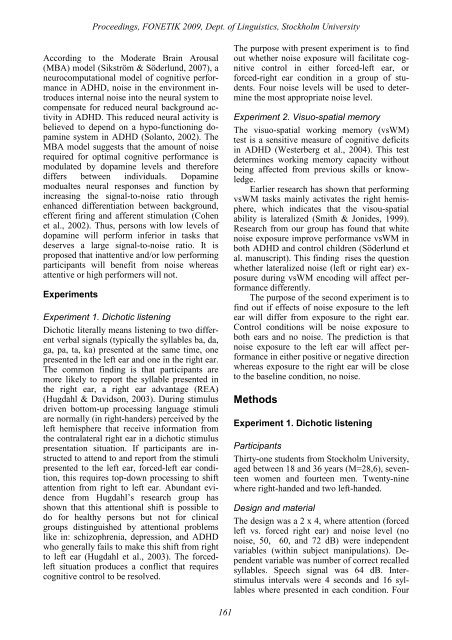Proceedings Fonetik 2009 - Institutionen för lingvistik
Proceedings Fonetik 2009 - Institutionen för lingvistik
Proceedings Fonetik 2009 - Institutionen för lingvistik
Create successful ePaper yourself
Turn your PDF publications into a flip-book with our unique Google optimized e-Paper software.
<strong>Proceedings</strong>, FONETIK <strong>2009</strong>, Dept. of Linguistics, Stockholm UniversityAccording to the Moderate Brain Arousal(MBA) model (Sikström & Söderlund, 2007), aneurocomputational model of cognitive performancein ADHD, noise in the environment introducesinternal noise into the neural system tocompensate for reduced neural background activityin ADHD. This reduced neural activity isbelieved to depend on a hypo-functioning dopaminesystem in ADHD (Solanto, 2002). TheMBA model suggests that the amount of noiserequired for optimal cognitive performance ismodulated by dopamine levels and thereforediffers between individuals. Dopaminemodualtes neural responses and function byincreasing the signal-to-noise ratio throughenhanced differentiation between background,efferent firing and afferent stimulation (Cohenet al., 2002). Thus, persons with low levels ofdopamine will perform inferior in tasks thatdeserves a large signal-to-noise ratio. It isproposed that inattentive and/or low performingparticipants will benefit from noise whereasattentive or high performers will not.ExperimentsExperiment 1. Dichotic listeningDichotic literally means listening to two differentverbal signals (typically the syllables ba, da,ga, pa, ta, ka) presented at the same time, onepresented in the left ear and one in the right ear.The common finding is that participants aremore likely to report the syllable presented inthe right ear, a right ear advantage (REA)(Hugdahl & Davidson, 2003). During stimulusdriven bottom-up processing language stimuliare normally (in right-handers) perceived by theleft hemisphere that receive information fromthe contralateral right ear in a dichotic stimuluspresentation situation. If participants are instructedto attend to and report from the stimulipresented to the left ear, forced-left ear condition,this requires top-down processing to shiftattention from right to left ear. Abundant evidencefrom Hugdahl’s research group hasshown that this attentional shift is possible todo for healthy persons but not for clinicalgroups distinguished by attentional problemslike in: schizophrenia, depression, and ADHDwho generally fails to make this shift from rightto left ear (Hugdahl et al., 2003). The forcedleftsituation produces a conflict that requirescognitive control to be resolved.The purpose with present experiment is to findout whether noise exposure will facilitate cognitivecontrol in either forced-left ear, orforced-right ear condition in a group of students.Four noise levels will be used to determinethe most appropriate noise level.Experiment 2. Visuo-spatial memoryThe visuo-spatial working memory (vsWM)test is a sensitive measure of cognitive deficitsin ADHD (Westerberg et al., 2004). This testdetermines working memory capacity withoutbeing affected from previous skills or knowledge.Earlier research has shown that performingvsWM tasks mainly activates the right hemisphere,which indicates that the visou-spatialability is lateralized (Smith & Jonides, 1999).Research from our group has found that whitenoise exposure improve performance vsWM inboth ADHD and control children (Söderlund etal. manuscript). This finding rises the questionwhether lateralized noise (left or right ear) exposureduring vsWM encoding will affect performancedifferently.The purpose of the second experiment is tofind out if effects of noise exposure to the leftear will differ from exposure to the right ear.Control conditions will be noise exposure toboth ears and no noise. The prediction is thatnoise exposure to the left ear will affect performancein either positive or negative directionwhereas exposure to the right ear will be closeto the baseline condition, no noise.MethodsExperiment 1. Dichotic listeningParticipantsThirty-one students from Stockholm University,aged between 18 and 36 years (M=28,6), seventeenwomen and fourteen men. Twenty-ninewhere right-handed and two left-handed.Design and materialThe design was a 2 x 4, where attention (forcedleft vs. forced right ear) and noise level (nonoise, 50, 60, and 72 dB) were independentvariables (within subject manipulations). Dependentvariable was number of correct recalledsyllables. Speech signal was 64 dB. Interstimulusintervals were 4 seconds and 16 syllableswhere presented in each condition. Four161
















